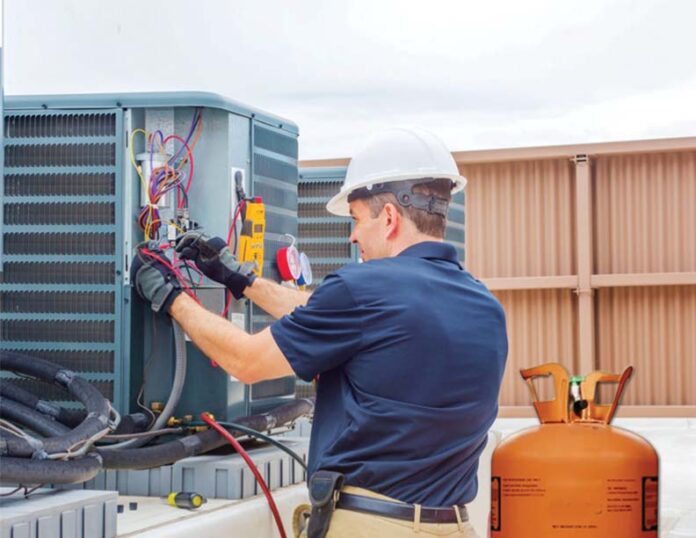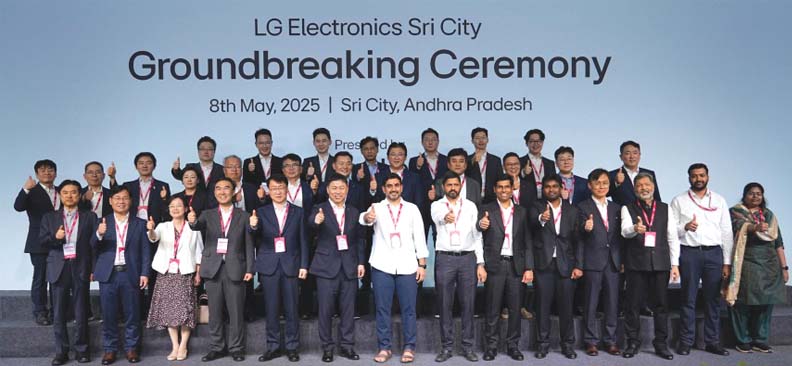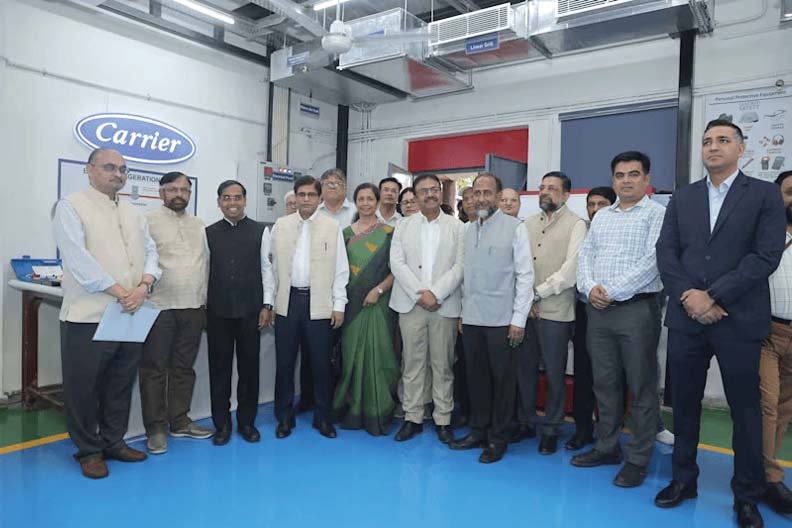
India is emerging as a strong contender to become a significant production hub for HVAC (Heating, Ventilation, and Air Conditioning) gadgets, particularly for air conditioners. Several factors are driving this growth, including increasing demand, government initiatives, and the expansion plans of major players.
According to a recent report from Research And Markets, titled “HVAC Systems Market in India 2025-2029,” the HVAC systems market in India is forecasted to grow by USD 3.50 billion during 2024-2029, accelerating at a CAGR of 10.5% during the forecast period.
A recent report, from Mordor Intelligence, states, “The India HVAC Market size is estimated at USD 12.14 billion in 2025, and is expected to reach USD 17.41 billion by 2030, at a CAGR of 7.5% during the forecast period (2025-2030).”
Why are the research organisations so optimistic?
Of late, a few factors together have been influencing the dynamics of the Indian HVAC industry. Primarily, the Indian HVAC market is experiencing substantial growth, fueled by rising temperatures, increasing disposable incomes, and urbanisation. The demand for cooling solutions in various sectors; including residential, commercial and industrial; is on the rise.
In this regard, the Indian government’s ‘Make in India’ initiative is encouraging local manufacturing, making India an attractive destination for HVAC companies looking to establish or expand their production facilities. Let me cite a few examples hereafter.
Japanese air conditioning giant Daikin has made significant investments in India, aiming to make it their largest global manufacturing hub by 2030. They have planned to double their manufacturing capacity and triple their exports of ‘Made in India’ products.
Carrier is also expanding its presence in India, focusing on increasing localisation and R&D. They are also encouraging their suppliers to set up operations in India to create a robust local supply chain.
South Korean conglomerate LG Corporation too is actively pursuing their presence in India.
Now, it is globally well-known that the HVAC products made in India are cost-competitive and reliable, making them attractive for both domestic and export markets – particularly in developing countries with similar weather patterns.
Also, as Indian manufacturers are now paying attention on energy-efficient HVAC systems and environmentally friendly refrigerants, a growing attention from the international buyers is being witnessed.
Role of our government
The Indian government is actively promoting the HVAC industry through several initiatives focused on energy efficiency, domestic manufacturing, and infrastructure development. In this regard, the key strategies include promoting energy-efficient technologies, incentivising domestic production under the ‘Make in India’ campaign, and investing in infrastructure projects that drive demand for HVAC systems.
BEE Star Ratings
The Bureau of Energy Efficiency (BEE) promotes energy-efficient appliances, including HVAC systems, through star-rating programs, encouraging consumers to choose more efficient models.
Energy Conservation Building Code (ECBC)
The ECBC sets standards for energy performance in commercial buildings, mandating the use of energy-efficient HVAC systems.
Perform, Achieve, and Trade (PAT) Scheme
This scheme encourages industries to adopt energy-efficient technologies, including HVAC, through incentives and targets.
‘Make in India’ Campaign
This initiative aims to bolster domestic manufacturing and reduce reliance on imports, including HVAC equipment.
Production Linked Incentive (PLI) Schemes
These schemes offer financial incentives to companies that increase production of specified goods, including HVAC components, further encouraging domestic manufacturing.
Incentives for Energy-Efficient HVAC
The government provides financial incentives and subsidies for the adoption of energy-efficient HVAC systems, particularly in air conditioning and refrigeration, making them more affordable.
Government Investments
Significant investments in infrastructure projects, such as roads, railways, and urban development, are creating a surge in demand for HVAC systems across various sectors.
Urbanisation
The increasing urban population in India is driving demand for HVAC systems in residential, commercial, and industrial spaces.
Commitment to Carbon Neutrality
India’s commitment to becoming carbon neutral by 2070 is encouraging the adoption of sustainable HVAC technologies, including eco-friendly refrigerants and renewable energy integration.
Focus on Super-Low GWP Refrigerants
The government is phasing out older refrigerants and promoting the adoption of new, more environmentally friendly options.
E-Waste Policy
New policies will ensure uniform standards for manufacturing and disposal of HVAC equipment, promoting responsible waste management.
ACREX India
This HVAC and intelligent building technology expo serves as a platform for manufacturers, government officials, and industry stakeholders to connect and showcase advancements.
By combining these strategies, the Indian government has been actively shaping the HVAC industry, fostering innovation, promoting energy efficiency, and contributing to a more sustainable future.
Examples of installation of more production facilities
Indian HVAC industry is experiencing increased installation of production facilities in 2025, driven by strong market growth and the ‘Make in India’ initiative. This expansion is being fueled by factors like urbanisation, infrastructure development, and a rising demand for energy-efficient cooling solutions.
Daikin
In 2025, Daikin is significantly expanding its production capacity for HVAC components in India, aiming to become a major manufacturing hub for exports. This expansion includes building a new plant near its existing facility in southern India, with the goal of doubling sales by 2025 and increasing production for global exports by 2026. The company is also planning to enhance local manufacturing of components like PCB circuits to achieve a higher level of localisation.
Carrier
In 2024, Carrier has expanded its HVAC products made in India with a range of Air Handling Units (AHUs) and Fan Coil Units (FCUs). These units are crafted to meet the diverse needs of India’s commercial buildings, providing custom solutions for healthy indoor environments with high-efficiency air filtering needs.
LG
LG Electronics India Ltd. (LGEIL), a subsidiary of LG Electronics Inc., a South Korean multinational corporation, has commenced construction of its new manufacturing facility in Sri City, Andhra Pradesh on May 8, 2025. The new plant is expected to commence operations by the end of 2026. The facility will manufacture a diverse range of products, including AC compressors, refrigerators and air conditioners.
Challenges that we need to overcome
Although a few present challenges are posing restrictions to the growth of the Indian HVAC industry, the above-mentioned initiatives by our government are mitigating most of them. However, considering the geopolitical situation and our internal waves of opposition and criticism for every decision of the government, like in all other industries our HVAC industry’s growth is getting affected.
Anyway, because of the growing global warming and pollution, expanding needs of this industry will continue to stay, and that will give rise to the trend of innovations. The target of all such developments from the manufacturers’ as well as consumers’ ends will be sustainability that includes the following:

Source – LG Electronics India Ltd.
Reducing the High Initial Cost
The initial cost of energy-efficient HVAC systems may be a barrier to adoption for some consumers. Manufacturers will continue to reduce the cost of production and economise their supply chains.
Developing Skilled Professionals
There is a shortage of skilled professionals for the installation and maintenance of HVAC systems. Several HVAC companies and training institutes in India are now offering programmes to train and certify technicians.
Energy Supply and Infrastructure
Challenges related to energy supply and infrastructure may hinder the growth of the market in certain regions. Our government has been working on it to improve the situation.
What is expected in this decade?
So far, I have discussed the status of the Indian HVAC industry based on the market reports and the steps taken by our government. Now, let me focus on the active participants’ (both small and big stake holders) views and actions on the future of this industry.
A blog from MACES Cooling Solutions concludes saying, “The Indian HVAC sector is no longer just about comfort – it is about health, sustainability, and smart infrastructure. The convergence of climate challenges, urban transformation, and technological disruption has turned this once-sleepy industry into a powerhouse of economic and environmental significance.
As India builds its future cities, the HVAC sector will be a silent yet critical enabler, ensuring energy-efficient, healthy, and adaptive indoor environments for millions. With the right mix of policy support, innovation, and skill development, India is well on its way to becoming a global leader in the HVAC domain.”
In India, LG is launching a new product development organisation this year and establishing a new production line at its Sri City plant, scheduled to open in 2026. This new line will support regional demand with an annual capacity of up to 1.5 million air conditioning units.
In April 2025, Carrier has launched its first Centre of Excellence for HVAC Skill Development in collaboration with Jamia Millia Islamia’s University Polytechnic, New Delhi. It clearly reflects the global company’s interest on the Indian HVAC market. In the launching ceremony, commenting on the company’s vision, Sundaresan Narayanan, Managing Director of Carrier India, said, Carrier’s commitment to innovation and societal progress is exemplified by our new Centre of Excellence for HVAC skill development. This initiative is a significant step toward India’s skill development mission, marking a key milestone in empowering the next generation of HVAC professionals. It equips them with the essential skills to drive advancements in energy-efficient and sustainable solutions.”

Source – Carrier India
Conclusion
One of the recent market survey reports of IMARC Group projects that India will witness an HVAC market size of $45.42 billion, with a CAGR of 16.16% between 2025-2033. The current market trend, including interest of the international players, indicates the potential of even surpassing that.
The hindrances in the path of growth are all of temporary nature. Indian government’s steps will soon smoothen the scenario.
Now, the Indian HVAC industry is poised for continued strong growth, driven by a combination of factors (as mentioned earlier) and presenting opportunities for both local and international players.
By P. K. Chatterjee (PK)








